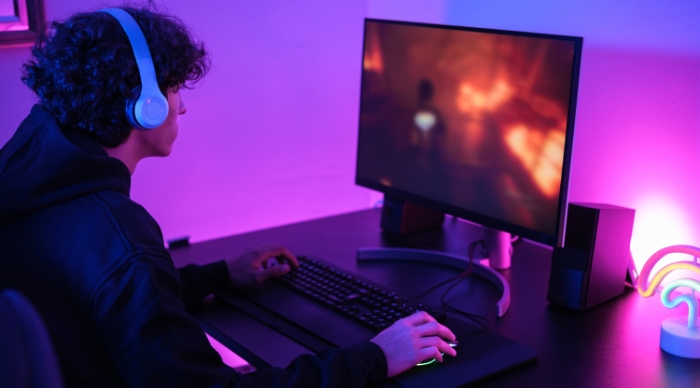Lag Spikes While Gaming: Combatting Disruptions

Experiencing a lag spike while deeply immersed in your favorite game can feel like hitting a speed bump at full throttle – it's jarring, disruptive, and often leaves you wondering what went wrong. Smooth gameplay is not just a luxury; it's a necessity for gamers, be they casual enthusiasts or competitive professionals.
But what exactly causes these sudden interruptions, where your character freezes or actions delay unexpectedly? This phenomenon, known as a lag spike, is a common plight that can ruin the gaming experience.
Our exploration into this issue isn't just about identifying the problem; it's about diving into its roots, understanding its various causes, and most importantly, finding effective solutions.
Identifying Lag Spikes
Lag spikes in gaming are like uninvited interruptions that can turn a winning moment into frustration. They are distinct from general lag and can significantly impact your gaming experience.
To effectively address these issues, it's crucial to first recognize and understand what constitutes a lag spike, how it differs from other types of lag, and the common signs that indicate their occurrence during gameplay.
What Are Lag Spikes?
A lag spike is a sudden and significant increase in latency or delay during an online gaming session. Unlike consistent lag, which is characterized by a steady delay, lag spikes are abrupt and often unexpected.
They occur when the flow of data between your gaming device and the game server is momentarily disrupted or slowed down. This disruption can last from a few seconds to several minutes, and its infrequent nature makes it particularly disruptive to the gaming experience.
Differentiating Lag Spikes from General Lag
It's important to differentiate between lag spikes and general lag, as their causes and solutions can vary. General lag is a consistent delay experienced during gaming, often due to a slow internet connection or inadequate hardware.
In contrast, lag spikes are sporadic, causing sudden drops in performance. Identifying whether you're dealing with a lag spike or general lag is key in finding the right solution.
Common Symptoms of Lag Spikes
Recognizing lag spikes involves observing specific symptoms during your gaming sessions:
- Stuttering Movements: Characters or game elements suddenly stutter or freeze momentarily, disrupting the fluidity of the game.
- Delayed Actions: There's a noticeable delay between your actions (like pressing a key) and the game's response.
- Sudden Frame Rate Drops: The game's frame rate unexpectedly falls, causing a jerky visual experience.
- Disconnection Errors: Temporary loss of connection or disconnections from the game server.
Understanding these symptoms is the first step in diagnosing and eventually tackling the issue of lag spikes, ensuring a smoother and more enjoyable gaming experience.
Causes of Lag Spikes
Lag spikes in gaming are not just random occurrences; they stem from a variety of sources ranging from network issues to hardware limitations. Understanding these causes is essential for gamers seeking a solution to this disruptive problem.
This part of the discussion delves into the primary factors that contribute to lag spikes, categorized into network-related, hardware-related, and software-related causes.
Network-Related Causes
- Unstable Internet Connection: The most common cause of lag spikes is an inconsistent internet connection. Fluctuations in your Wi-Fi or wired connection can result in temporary lapses in data transmission.
- Bandwidth Limitations: If multiple devices are using the same network, the available bandwidth might be insufficient, leading to periodic spikes.
- Router Issues: An outdated or malfunctioning router can struggle to maintain a stable connection, especially when multiple devices are connected.
Hardware-Related Causes
- Insufficient System Resources: Lag spikes can occur if your computer lacks the necessary RAM or processing power to handle the game efficiently.
- Overheating of Components: Overheated CPUs or GPUs can throttle performance, causing sudden drops in frame rate and responsiveness.
- Outdated or Malfunctioning Network Adapters: An outdated or faulty network adapter can disrupt the connection between your computer and the router.
Software-Related Causes
- Background Applications: Programs running in the background can consume significant system resources, impacting the game's performance.
- Out-of-Date Drivers or Game Patches: Using outdated drivers for your hardware or not updating your game to the latest version can lead to performance issues.
- Issues with the Game Server: Sometimes, the problem lies not with your setup but with the game server itself, which can experience its own lag spikes.
Diagnosing the Problem

Accurately diagnosing the cause of lag spikes is a critical step in resolving them. It involves a methodical approach to test various elements of your gaming setup, from hardware to network connectivity.
This process helps isolate the issue, whether it's a local problem with your device or a broader issue with the game server or internet connection.
Tools and Methods to Monitor Network Stability
- Network Speed Tests: Regularly conducting speed tests can help monitor the consistency of your internet connection.
- Ping Tests: Using ping tests to assess the latency between your device and the game server can indicate if network lag is the issue.
- Router Diagnostics: Many modern routers offer built-in diagnostic tools to check for connectivity and performance issues.
Assessing Computer Hardware and Software Status
- Resource Monitoring: Tools like Windows Task Manager or Mac Activity Monitor can reveal if your system is overtaxed during gaming.
- Hardware Check: Ensuring that all hardware components are functioning correctly and are not overheating is vital.
- Software and Driver Updates: Verifying that your operating system, game, and hardware drivers are up to date can help eliminate software-related issues.
Steps to Isolate the Cause
- Testing Different Games: If the issue persists across multiple games, it's likely a problem with your system or network rather than a specific game.
- Using Different Devices: Trying another device on the same network can help determine if the problem is with the computer or the internet connection.
- Checking Server Status: For online games, checking the game server's status can reveal if the issue is on the server side.
Solutions to Combat Lag Spikes
Once the cause of lag spikes is identified, the next step is to implement solutions that can mitigate or eliminate this issue. The strategies vary based on the root cause, whether it's network-related, hardware-related, or software-related.
This section provides a comprehensive guide to address each type of cause, offering practical solutions to enhance gaming performance.
Network-Based Solutions
- Improving Internet Connection: Switching to a wired Ethernet connection can provide a more stable and faster internet connection than Wi-Fi.
- Optimizing Router Settings: Updating router firmware and adjusting settings for better performance can help. Consider using Quality of Service (QoS) settings to prioritize gaming traffic.
- Managing Bandwidth Usage: Ensure that other devices on the network are not consuming excessive bandwidth during gaming sessions.
Hardware-Based Solutions
- Upgrading Hardware Components: If hardware limitations are causing lag spikes, consider upgrading components like RAM, CPU, or GPU.
- Ensuring Proper Ventilation and Cooling: Keep your gaming system cool with proper ventilation or additional cooling solutions to prevent overheating.
- Checking Network Adapters: Replace outdated or malfunctioning network adapters to ensure a reliable connection.
Software-Based Solutions
- Updating Drivers and Game Patches: Regularly update your system's drivers and game patches to ensure optimal performance.
- Closing Unnecessary Background Applications: Shut down applications and services running in the background that are not essential for gaming.
- Adjusting Game Settings: Lowering game graphics settings can reduce the strain on your system, potentially minimizing lag spikes.
Preventative Measures
Proactive steps can often prevent lag spikes before they disrupt your gaming experience. These preventative measures encompass a range of practices, from regular maintenance of your gaming equipment to making informed choices about your internet service.
Implementing these strategies not only minimizes the risk of encountering lag spikes but also enhances the overall performance and longevity of your gaming setup.
Regular Maintenance of Gaming Equipment
- Cleaning Hardware: Regularly clean your computer or gaming console to prevent dust buildup, which can lead to overheating.
- Checking for Physical Damage: Periodically inspect hardware components for signs of wear or damage, which can affect performance.
- System Health Checks: Use diagnostic tools to monitor the health of your hardware components, ensuring they are functioning optimally.
Choosing the Right Internet Plan for Gaming
- Assessing Bandwidth Needs: Choose an internet plan that meets the bandwidth requirements of your gaming and other online activities.
- Reliability Over Speed: While high-speed internet is important, reliability and low latency are crucial for online gaming.
- Considering Internet Service Providers (ISPs): Select an ISP known for stable connections and good customer support.
Keeping Software and Hardware Up-to-Date
- Regular Software Updates: Keep your operating system, games, and drivers updated to ensure compatibility and performance optimization.
- Hardware Upgrades: Stay informed about new hardware developments and consider upgrades when your current setup no longer meets gaming demands.
Educating About Common Pitfalls and Best Practices
- Staying Informed: Keep up with the latest gaming and technology news to be aware of common issues and their solutions.
- Community Engagement: Participate in gaming forums and communities to learn from the experiences and advice of other gamers.
- Learning from Experience: Pay attention to how different settings and changes affect your gaming performance and adjust accordingly.
Conclusion
Lag spikes in gaming, though disruptive, are not insurmountable challenges. This article has guided you through a journey from identifying these sudden interruptions to exploring their various causes, be they network, hardware, or software-related.
Equipped with strategies for diagnosing these issues, you now have a clearer path to finding solutions that address the specific causes of your gaming woes. From optimizing your network connection and updating hardware to tweaking software settings, each step is crucial for enhancing your gaming experience.
Moreover, the importance of preventative measures cannot be overstated. Regular maintenance of your gaming setup and staying informed about the latest technological trends go a long way in ensuring a seamless gaming experience.
Remember, lag spikes are a common issue, but with the right knowledge and tools, they can be effectively managed, allowing you to enjoy your gaming sessions to the fullest.


